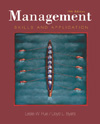 |  Management: Skills and Application, 10/e Leslie W Rue,
Georgia State University - Emeritus
Lloyd L Byars,
Georgia Institute of Technology
The Management Movement
Chapter Summary| 1. Explain why management did not emerge as a recognized discipline until the twentieth century. Just as traffic lights were not needed before cars, management, as it now exists, was not needed before organizations became complex. Before the late nineteenth and twentieth centuries, most organizations were relatively simple. Industrialization and mass production brought large and complex organizations.
2. Describe the three facets of the U.S. Industrial Revolution. The three major facets of the U.S. Industrial Revolution are (1) power (2) transportation, and (3) communication.
3. Discuss the role the captains of industry played in the development of modern organizations. The captains of industry, who included John D. Rockefeller, James B. Duke, Andrew Carnegie, and Cornelius Vanderbilt, built great companies. They introduced nationwide distribution and marketing methods. Because of the size and dominance of these companies, the relationship between business and government changed forever. Government passed legislation to check corporate practices in restraint of trade.
4. Define scientific management and outline the role Frederick W. Taylor and his contemporaries played in its development. Scientific management is a philosophy about the use of human effort. It seeks to maximize output with minimum effort through the elimination of waste and inefficiency at the operative level. Frederick W. Taylor was the major figure responsible for popularizing scientific management through his writings and consulting. Several contemporaries of Taylor helped spread Taylor's philosophy through their own efforts. The most prominent included Carl Barth, Morris Cooke, Henry Gantt, and Frank and Lillian Gilbreth.
5. Summarize Henri Fayol's contributions to modern management. Henri Fayol made many contributions, but the most significant was his development of management principles and elements. The 14 principles Fayol developed are still applicable today, and his five management elements are very similar to today's functions of management.
6. Discuss the human relations thrust in management, with emphasis on the role of the Hawthorne experiments. Following the Great Depression, more emphasis began to be placed on understanding workers and their needs. The Hawthorne studies, which began in 1924 and lasted until 1932, focused attention on human relations and specifically on the psychological and sociological aspects of work. Mary Parker Follett also helped to popularize the human relations movement.
7. Define the management process period, the management theory jungle, the systems approach, and the contingency approach. The management process period took place between the late 1940s and the late 1950s. During this period, management thought focused primarily on identifying and refining the functions or components of the management process. The management theory jungle, first clearly identified by Harold Koontz, referred to the many different approaches being taken to the study of management in the late 1950s and early 1960s. The systems approach attempted to integrate the various approaches to management. The systems approach is a way of thinking about the job of managing that provides a framework for visualizing internal and external environmental factors as an integrated whole. The contingency approach to management theorizes that different situations and conditions require different management approaches and that no one approach works best in all situations.
8. Compare the major differences in the American, Japanese, and Theory Z organizations. In general terms, American organizations place emphasis on individual responsibility, whereas Japanese organizations place more emphasis on collective decision making, slow evaluation and promotion, and holistic concern for employees. Theory Z attempts to combine the American emphasis on individual responsibility with the Japa-nese emphasis on collective decision making and responsibility. Figure 2.4 summarizes the major points of each type of organization.
9. Summarize the eight characteristics of excellent companies identified by Peters and Waterman. In their book In Search of Excellence, Peters and Waterman identified eight characteristics of excellent companies (see Figure 2.5). In general, these eight characteristics emphasize the value of on-the-job experimentation and creative thinking, the need to place the customer first, and the need to treat employees as human beings.
10. Explain why the international aspects of management are currently being emphasized. Many of today's U.S. companies have turned to the international arena for new markets and profits. Even those companies that do not trade internationally are often greatly affected by imports or exports from other countries. Thus, almost all companies today are affected to some degree by the international aspects of management.
11. Discuss some predictions as to how managers might manage in the twenty-first century. Organization structures may become extremely fluid with no structured departments, units, divisions, or functional groups. The barriers between leader and follower, manager and worker will disappear. Managers will act as coordinators of team activities. |
|



 2003 McGraw-Hill Higher Education
2003 McGraw-Hill Higher Education